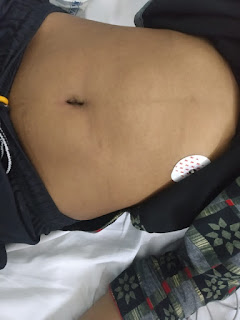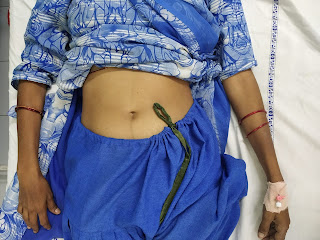Bimonthly assessment for March 2021
This is my submission of bimonthly assessment for March 2021
Link to the assignment is below:
https://medicinedepartment.blogspot.com/2021/03/medicine-paper-for-march-2021-bimonthly.html?m=1
1.
Link to the blog:
https://ashakiran923.blogspot.com/2021/03/60-years-old-male-fever-under-evaluation.html?m=1
1 a). What is the problem representation of this patient and what is the anatomical localization for his current problem based on the clinical findings?How specific is his dilated superficial Abdominal vein in making diagnosis?
About his superficial abdominal veins :
For a long term alcoholic, he could be a risk factor to develop portal hypertension, which may be present with superficial abdominal veins and varices
Other differentials include:
Caput medusae due to portal hypertension
Dilated veins in IVC
Congenital
Obstruction of IVC
1b. What is the etiology of the current problem and how would you as a member of the treating team arrive at a diagnosis? What is the cause of his hypoalbuminemia?Why is the SAAG low?
Ans:Etiology/causes could be: Alcoholism affecting liver, Smoking affecting his oral cavity causing aphthous ulcers
Patients with advanced cirrhosis almost always have hypoalbuminemia caused both by decreased synthesis by the hepatocytes and water and sodium retention that dilutes the content of albumin in the extracellular space
c)Will PT,INR derangement preceed hypoalbuminemia in liver dysfunction??Share reference articles if any!
The liver plays a central role in the clotting process, and acute and chronic liver diseases are invariably associated with coagulation disorders due to multiple causes: decreased synthesis of clotting and inhibitor factors, decreased clearance of activated factors, quantitative and qualitative platelet defects, hyperfibrinolysis, and accelerated intravascular coagulation.
https://www.medscape.com/answers/177354-36077/what-is-the-role-of-prothrombin-time-pt-in-the-evaluation-of-acute-liver-failure
d)What is the etiology of his fever and pancytopenia?
e)Can there be conditions with severe hypoalbuminemia but no pedal edema? Can one have hereditary analbuminemia and yet have minimal edema? Please go this article https://www.
Yes
Inflammation and infection
Albumin is considered a negative acute phase reactant, which means that as inflammation and other acute physiologic processes occur, its levels decrease
In liver disease:Albumin is synthesized in the liver, and low serum albumin can be indicative of liver failure or diseases such as cirrhosis and chronic hepatitis. If present, hypoalbuminemia is generally considered to be a sign of advanced hepatic cirrhosis, or irreversible damage to the liver
Malnutrition or malabsorption
Low albumin levels can also indicate chronic malnutrition from protein losing enteropathy.[3] This is often caused or exacerbated by ulcerative colitis,[10] but can also be seen in cardiac disease and systemic lupus erythematosus
f) What is the efficacy of each of the drugs listed in his current treatment plan
Drug listed is Tamsulosin
And it’s efficacy is
α1-Adrenergic receptor antagonists are used by 80% of physicians as the first agent to treat patients with benign prostatic hyperplasia (BPH) presenting with lower urinary tract symptoms (LUTS); 27 of 30 clinical trials have confirmed that α-blockers are effective for BPH treatment.
2.Tamsulosin's α1A subtype adrenergic receptor selectivity is considered to be responsible for its low cardiovascular side effects and lack of interaction with antihypertensives.
3.A 4-year extension, multicenter, open-label, phase IIIB clinical study evaluated long-term efficacy, safety, and tolerability of tamsulosin for up to 6 years; the study found a consistent statistically significant improvement in AUA symptom scores over 6 years, and most patients showed improvement during the first year that was sustained over 6 years.
4.The low incidence of acute urinary retention in patients treated with tamsulosin for up to 6 years suggests that tamsulosin may reduce the risk of AUR in patients with BPH.
5.Response to treatment and incidence of adverse events (eg, rhinitis and abnormal ejaculation) in patients with hypertension, diabetes, or nonhypertensive cardiovascular disease did not differ significantly from that in those without.
6.Abnormal ejaculation is an important side effect of tamsulosin, but it resulted in few discontinuations during treatment. It may not always be deemed important by patients, and was not linked to complaints of decreased libido, impotence, or other changes in sexual function.
https://www.ncbi.nlm.nih.gov/pmc/articles/PMC1477608/
Nitrofurantoin efficacy:
comparing 3 days of nitrofurantoin with placebo in young women with symptoms of UTI and pyuria found clinical cure rates of 70% versus 42%, respectively, 7 days after the start of therapy.
The prevalence of participants with side effects attributed to nitrofurantoin in the 17 studies generally ranged from 5% to 16%; nausea, abdominal discomfort and headaches were described. An exception was an open-label randomized controlled trial whose primary outcome was quality of life.
https://academic.oup.com/jac/article/70/9/2456/721364
2. Link to the blog :
45year old female with abdominal distension
a). What is the problem representation of this patient and what is the anatomical localization for her current problem based on the clinical findings?
A 45 year old female with complaints of abdominal distension since 2 years and pedal edema since 2 months, with increasing distension causing difficulty in eating drinking ,though she has a good appetite and unable to fulfill it.
She’s k/c/o DM since one year.Took medicines for 6 months and stopped.
All of the above complaints point to liver pathology.
b) What is the etiology of her refractory ascites and pleural effusion? and how would you as a member of the treating team arrive at a diagnosis?
Refractory ascites is defined as ascites that does not recede or that recurs shortly after therapeutic paracentesis, despite sodium restriction and diuretic treatment. To date, there is no approved medical therapy specifically for refractory ascitis
The diagnostic criteria of refractory ascites consist of ascites that cannot be mobilized with early recurrence within 4 weeks of abdominal paracentesis and lack of response to maximal doses of diuretic (spironolactone 400 mg/d and furosemide 160 mg/d) for at least 1 week.
c) Approach to a patient with ascites?Clinically is there any way to differentiate pre hepatic, post hepatic and hepatic causes?
Ultrasonically determine the degree of ascites.
Based on the degree of ascites ascitic tap or paracentesis should be done and evaluate the ascitic fluid
For saag serum ascitic albumin gradient l.
she is on diuretics,frequent therapeutic paracentesis
Her RFT was normal _no renal failure,
Noincreased cell counts in ascitic fluid, no features of infection _rule out SBP
No H/O 7se of NSAIDS
On CECT abdomen_ no tumors identified in liver
No symptoms of GI bleeding:melena,hemetemesis.
So in this case most probably ascitis due to portal hypertension :
DD: cirrhosis of liver
Schistosomiasis
Portal vein outflow obstruction.
Cirrhosis is ruled out clinically no symptoms like jaundice,no coagulation disorders,no other signs of liver cell failure radiologically no altered echotexture,no shrunken liver,no nodules .
Stool microscopy was done to rule out schistosomiasis.
Portal vein thrombosis evaluation done by triple phase cect followed byMR Venogram.
On triple phase CECT :Focal short segment of intrahepatic segment of IVC just below the diaphragm with normal hepaticveins And multiple osteosclerotic lesions in pelvis,ribs,vertebral bodies __sarcoidosis /metastasis.
MR Vengram_ suggested severe narrowing of intrahepatic portion of IVC___Chronic buud chiari syndrome.
PLEURAL EFFUSION:
When pleural and Ascitic tap done on same time sent for analysis _both looks like almost same _both are transudates:so, pleural effusion is most likely due to Hepatic hydrothorax.
DD: 1.sarcoidosis:
2.tuberculosis: pleural fluid and sputum for AFB and CBNAAT was negative.clinically no h/o TB.
3.Malignancy: pleural fliuid cytology was normal ,no dysplastic cells
d)Causes of budd chiari syndrome?Why did the patient undergo bone biopsy?
Hypercoagulable states:
Inherited : Anti thrombin deficiency, Protein c deficiency,protein S deficiency,Factor v leiden mutation, prothrombin mutation
Acquired :Myeloproliferative disorders,PNH,Anti phospholipid syndrome,cancer,pregnancy,ocp use
Uncommon causes: HCC,RCC,Adrenl carcinoma
Misc: Aspergillosis,behcet syndrome,IVC webs,trauma,IBD,systemic sarcoidosis.
IN THIS CASE BONE BIOPSY DONE FROM POSTERIOR ILIAC CREST ON LEFT SIDE TO EVALUATE THE OSTEOSCLEROTIC LESIONS IN PELVIS , RIBS, VERTEBRAE .
d) Management strategies for refractory ascites and Budd chiari syndrome? Share the potential advantages and disadvantages of Peritoneal dialysis catheter placement in refractory ascites?
Treatment
Treatment of Budd-Chiari syndrome is most successful if the disorder is diagnosed early. There are also various methods of treatment. The use of high doses of the corticosteroid drug, prednisone, may also be administered. Drugs that hinder blood clotting (anticoagulants) such as heparin may be beneficial for treatment of individuals with Budd-Chiari syndrome.
Surgical widening (dilation) of affected veins (angioplasty) may ease high pressure in the vessel walls. In some cases, Budd-Chiari syndrome may be treated surgically by diverting blood flow from one vein to another (shunting). In other cases, a blocked vein may be cleared out and then a slender rod (stent) may be inserted into the vein to maintain blood flow. In serious cases of Budd-Chiari syndrome, liver transplantation may be necessary.
Management of BCS:
1.Diagnosis of BCS made by clinical features, laboratory and radiological investigations , management of underlying cause
2.Anti coagulant therapy with LMWH and then warfarin aim for INR 2_3
3.Treat the complications of portal hypertension with spirinolactone ,furosemide,and gastroscopy for variceal screening and band ligation
4.consider angioplasty /stenting for venous obstruction
5.consider TIPS if no improvement with anticoagulation , angioplasty, stenting.
6.TIPS fails /no improvement and acute liver failure consider liver transplantation.
7.Monitor chronic BCS for HCC by 6 monthly USG and alpha fetoprotein.
Peritoneal dialysis catheter in refractory ascitis:
Advantages:
Heamodynamic stability
Ascitis control directly and in continuing fashion
Easy catheter placement
Disadvantages:
Protein loss
Over drainage of ascitis lead to hypotension
Dialysate leak or hydrothorax
Poor clearance owing to volume of ascitis
Higher infection risk .
https://clinicaltrials.gov/ct2/show/NCT02975726
e) What is the efficacy of each of the drugs listed in his current treatment plan
Lasilactone
https://www.medicines.org.uk/emc/product/907/smpc
Warfarin and LMWH:
https://emedicine.medscape.com/article/184430-medication
f)What is the current outcome?and what could be the etiology of her current outcome?
Ans:
Patient got expired on14th of march preceded h/o vomiting and nausea
Cause of death was not confirmed, may be because of dislodgement of thrombus leading to pulmonary embolism.
QUESTION 3
55year old male with SOB and abdominal distension,orthopnea
https://jayanth1802.blogspot.com/2021/02/55-year-old-farmer-with-sob-abdominal.html?m=1
a). What is the problem representation of this patient and what is the anatomical localization for his current problem based on the clinical findings?
Based on the clinical findings the problem in this patient is with his heart.
Based on the detailed history and clinical findings the provisional diagnosis would be- k/c/o cor pulmonale with severe pulmonary arterial hypertension grade III with gross ascitis with acute kidney injury.
b) What is the etiology of his ascites? and how would you as a member of the treating team arrive at a diagnosis?Chart out the sequence of events!
The reason for ascitis in this patient could be RHF. RHF leads to congestive hepatomegaly and thereby derranging the synthetic funtion of the liver to produce albumin. And hypoalbuminemia leads to fluid accumulation.
AKI can also lead to ascitis due to increased salt and water retention.
COPD---->RHF----> congestive hepatomegaly----> reduced protein synthesis----> ascitis due to fluid accumulation.
Decreased urine output--->AKI---> Salt and water retention ----> ascitis.
c)What is the efficacy of each of the drugs listed in his treatment plan?
d)What are his current outcomes ?
QUESTION 4
4)Please go through the thesis presentation below and answer the questions below by also discussing them with the presenter
https://youtu.be/QlPrb1BSHGE
a)What was the research question in the above thesis presentation?
-Role of SAAG in diagnosing the etiology of ascitis.
b) What was the researcher's hypothesis?
c)What is the current available sensitivity and specificity of SAAG in diagnosis of etiology of ascites
When using the SAAG cut-off value 11 g/L, its sensitivity and specificity were 100.00% and 85.19% with an accuracy of 94.37%.
https://diagnosticpathology.biomedcentral.com/articles/10.1186/1746-1596-8-143#:









Comments
Post a Comment